05【执行计划、SQL语句调优、海量数据插入】
一、获取SQL瓶颈
1.1 执行计划
项目开发中,性能往往都是是我们重点关注的问题,其实很多时候一个SQL往往是整个请求中瓶颈最大的地方,因此我们必须了解SQL语句的执行过程、数据库中是如何扫描表、如何使用索引的、是否命中索引等信息来帮助我们做SQL语句的优化。MySQL提供了explain/desc语句,来显示这条SQL语句的执行计划,执行计划可以帮助我们查看SQL语句的执行情况,我们可以根据反馈的结果来进行SQL的优化。
准备数据
use test;
CREATE TABLE `role` (
`id` int(11) NOT NULL,
`name` varchar(255) CHARACTER SET utf8 COLLATE utf8_general_ci NULL DEFAULT NULL,
PRIMARY KEY (`id`) USING BTREE
) ENGINE = InnoDB CHARACTER SET = utf8 COLLATE = utf8_general_ci ROW_FORMAT = Dynamic;
CREATE TABLE `user` (
`id` int(11) NOT NULL,
`name` varchar(255) CHARACTER SET utf8 COLLATE utf8_general_ci NULL DEFAULT NULL,
`role_id` int(11) NULL DEFAULT NULL,
PRIMARY KEY (`id`) USING BTREE
) ENGINE = InnoDB CHARACTER SET = utf8 COLLATE = utf8_general_ci ROW_FORMAT = Dynamic;
insert into role values(1,'保洁');
insert into role values(2,'保安');
insert into role values(3,'厨师');
insert into user values(1,'zs',1);
1)id 字段
id字段存在三种情况:
1)id相同:id越靠前的表越先执行
explain select * from user u left join role r on u.role_id=r.id;

2)id不同:id越大的表越先执行
explain select * from user u where u.role_id=(select id from role r where r.id=1);

3)id有相同,也有不同:id越大的表越先执行,在id相同的表中,id越靠前的表越先执行
2)select_type 字段
- SIMPLE:简单的 select 查询,查询中不包含子查询或者 union
explain select * from user;

- PRIMARY:查询条件中包含有子查询时最外层的表(u1)
explain select * from user u1 where u1.id =(select id from user u2 where u2.id=1);

- UNION(u2):使用到union关联时,union关联的表
- UNION RESULT(<union1,2>):使用union时,最终的结果集表
explain select * from user u1 union select * from user u2;

- SUBQUERY(u2):条件子查询中的表
explain select * from user u1 where u1.id =(select id from user u2 where u2.id=1);

- SUBQUERY(u2,u3):条件中的子查询中的表(包括多重层级)
explain select * from user u1
where u1.name =(
select name from user u2 where u2.name=(select name from user u3 where u3.name='zs')
);

- DEPENDENT SUBQUERY(r1): 子查询中的条件依赖于外部的查询(r1的条件是u1表中的数据)
explain select * from user u1 where u1.role_id=(select id from role r1 where u1.id=1);

3)table 字段
表示该SQL语句是作用于那张表的,取值为:表名、表别名、衍生表名等。
explain select * from user;
explain select * from user u1;

4)partitions 字段
涉及到分区的表
准备数据:
create table goods_partitions (
id int auto_increment,
name varchar(12),
primary key(id)
)
partition by range(id)(
partition p0 values less than(10000),
partition p1 values less than MAXVALUE
);
查看mysql的物理存储路径:
show variables like '%dir%';
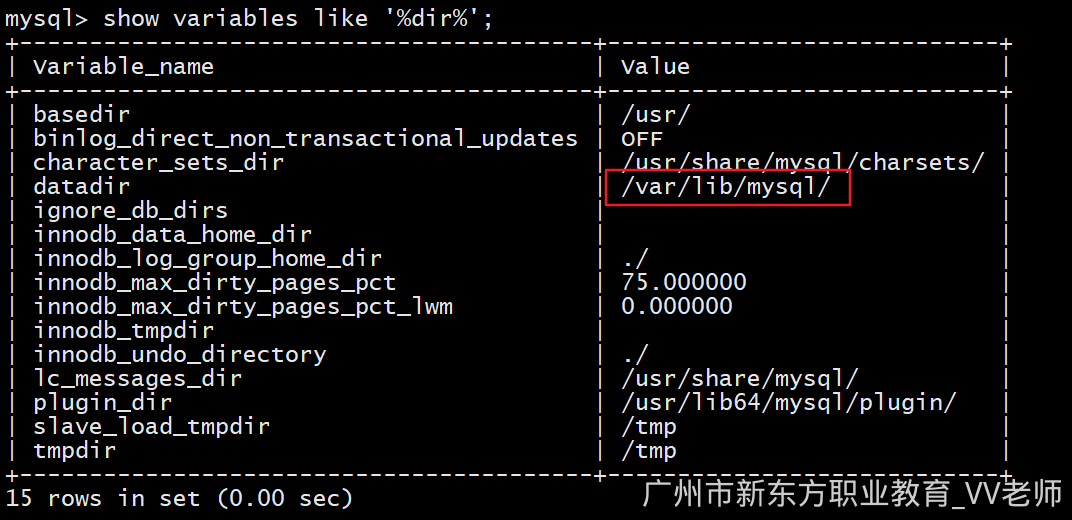
查看物理存储文件,发现多了不同的文件来存储

查看查询语句所使用到的分区:
explain select * from goods_partitions;

explain select * from goods_partitions where id<1000;

5)type 字段
反应一段sql性能指标的重要参数,可以通过此参数来判断是否使用到了索引、是否全表扫描等。
- null:代表不访问任何表
explain select 1;

- system:表中只有一条记录,并且此表为系统表(一般很少出现),const类型的特例;
use mysql; -- 切换到mysql数据库
explain select * from db where host='localhost';

- const:通过唯一索引或者是主键查询到的数据(极高)
分别根据name和id查询,发现只有id的type为const。
explain select * from user where id=1;
explain select * from user where name='zs';

给name字段加上唯一索引(必须要是唯一索引,普通索引不行):
create unique index user_name_unique on user(name);

测试完毕删除唯一索引:
drop index user_name_unique on user;
- eq_ref:使用主键的关联查询,并且表中只有一条记录与主表匹配;
explain select * from user u left join role r on u.role_id=r.id;

代表r表使用到了主键来关联查询
- ref:通过非唯一索引查询到的数据
创建普通索引:
create index user_name_index on user(name);
查询执行计划:
explain select * from user where name='zs';

测试完毕删除索引:
drop index user_name_index on user;
- range:使用索引的范围查询(普通列的范围查询不会是range)
我们执行如下两句sql查看执行计划:
explain select * from user u where u.id>20; -- 使用索引列进行范围查询
explain select * from user u where u.role_id>20; -- 使用普通列进行范围查询

给role_id列添加索引,再次执行sql,查看执行计划:
create index user_role_id_index on user(role_id);
explain select * from user u where u.role_id>20;

测试完毕,删除索引:
drop index user_role_id_index on user;
由于我们的表建立的是逻辑外键,不是真实的外键,因此role_id不是索引字段,如果是真实外键那么该列是索引字段
- index:查询的是索引列,遍历了索引树
explain select id from user;

- ALL:效率最低,遍历全表
explain select * from user;

查询效率从高到底的取值为:
NULL > system > const > eq_ref > ref > fulltext > ref_or_null > index_merge > unique_subquery > index_subquery > range > index > ALL
system > const > eq_ref > ref > range > index > ALL
tips:一般我们在开发中,应该尽量达到range级别,避免all,最好优化成ref级别。
6)possible_keys 字段
查询语句中,可能应用到的索引,并非实际使用到的索引。实际使用到的索引根据key字段来反应。
7)key 字段
key字段反应sql语句实际使用的索引,为null代表没有使用索引
我们知道MySQL底层是有优化器的,具体是否走索引MySQL会根据优化器来决定,有时候我们指定了索引查询,MySQL优化器认为不走索引效率可能会更高,因此执行计划possible_keys 字段显示走了索引,但实际上key字段为null(没走索引)
8)key_len 字段
表示索引中使用的字节数
查看如下sql的执行计划:
explain select * from user u where id=1;

possible_keys :PRIMARY,代表此sql语句可能使用到了主键索引。
key:PRIMARY,代表此sql语句使用到了主键索引。
key_len:此主键索引的长度为4个字节(int占4个字节)。
9)ref 字段
表示某表的某个字段引用到了本表的索引字段,并且表(r表)中只有一条记录与主表匹配;
explain select * from user u,role r where u.role_id=r.id;

表示u表的role_id引用了本表(r表)的索引字段(PRIMARY)
使用其他索引列关联表:
create index role_name_index on role(name); -- 给name列加索引。
explain select * from user u ,role r where u.name=r.name; -- 使用name列来关联

表示u表的name字段引用了本表(r表)的索引字段(role_name_index)
测试完毕删除索引:
drop index role_name_index on role;
- ref值为const:代表使用索引查询
explain select * from user u where u.id=1;

无论是主键索引还是唯一索引或者是普通索引ref的值都为const
create index user_index_name on user(name); -- 创建普通索引
explain select * from user u where u.name='1';

测试完毕删除索引:
drop index user_index_name on user;
10)rows 字段
根据表统计信息及索引选用情况,大致估算出找到所需的记录或所需读取的行数。
explain select * from user;
explain select * from role;

user表中有1条记录,role表中有3条记录。
11)filtered 字段
表示返回结果的行数占需读取行数的百分比, filtered 的值越大越好。
在user表中,插入一条新的记录,这条记录在role中关联不到,然后使用表管理查询数据
insert into user values(2,'ls','4');
explain select * from user u inner join role r on u.role_id=r.id;
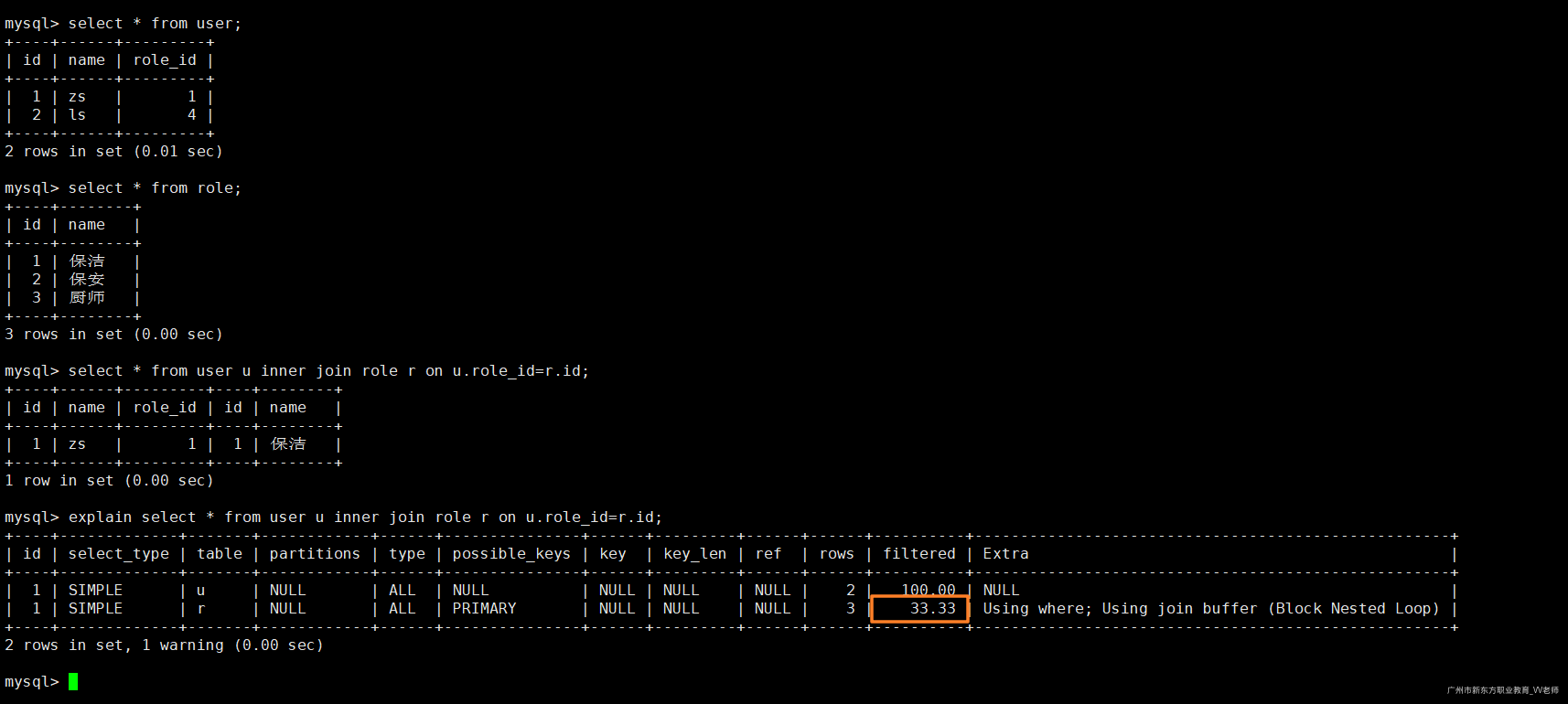
r表实际记录3条,上述sql语句关联查询出来的结果只能得出一条结果集,因此命中率为33.33%。
select * from user u inner join role r on u.role_id=r.id;

12)extra 字段
显示其他扩展信息
- Using filesort:排序时无法使用到索引时,就会出现这个。常见于order by和group by语句中。效率低
explain select name from user order by name;

- Using temporary:表示SQL语句的操作使用到了临时表。
explain select name from user group by name;

- Using index:代表使用到了索引,效率高
create index user_name_index on user(name); -- 创建索引
explain select name from user order by name;
explain select name from user where name='1';

测试完毕删除索引:
drop index user_name_index on user;
- Using where:扫描全表。通常是查询条件中不是索引字段。
explain select * from user where name='zs';

- NULL:没有用到额外的附加条件
explain select * from user where id=1;

性能对比:
Using index>NULL>Using where>Using temporary>Using filesort
1.2 SQL监控
1.2.1 show processlist
- show processlist:显示连接当前数据库的一些信息,包括连接者的ip、在做什么操作、连接的数据库等。
show processlist;

注意:如果当前用户是root账号,则可以查阅到所有用户的连接信息,否则只能查询到自己的连接信息。
- id:用户登录mysql时,系统自动分配的一个用于唯一标识此用户的id号,可以通过
connection_id()函数查询
select connection_id();

- user:连接mysql数据库的用户,如果不是root用户,那么只显示自己
- host:连接mysql数据库用户的ip、端口
- db:显示对方连接的数据库,如果没有选择数据库,默认为
NULL - command:显示当前连接正在执行的命令,取值如下:
- sleep:表示当前连接并没有做任何操作,处于休眠状态
- query:表示当前连接正在执行查询操作
- connect:表示当前连接正在连接mysql数据库
- Locked:线程正在等待表锁的释放
- Sorting result:线程正在对结果进行排序
- Sending data:线程正在向请求端返回数据
- time:显示command的某个状态连续持续了多长时间,单位:秒。
- state:显示当前连接执行的sql语句状态。
- info:显示当前连接执行的sql语句。
注意:show processlist只会显示100条记录,如果记录超过100条,那么请使用
show full processlist
1.2.2 查询SQL消耗时间
- 数据准备:准备300W的数据做测试。
CREATE TABLE `userinfo` (
`id` int(10) NOT NULL COMMENT '用户id',
`username` varchar(50) CHARACTER SET utf8 COLLATE utf8_general_ci NULL DEFAULT NULL COMMENT '用户名',
`age` int(3) NULL DEFAULT NULL COMMENT '年龄',
`phone` varchar(15) CHARACTER SET utf8 COLLATE utf8_general_ci NULL DEFAULT NULL COMMENT '手机号',
`gender` char(1) CHARACTER SET utf8 COLLATE utf8_general_ci NULL DEFAULT NULL COMMENT '性别: ‘0’-男 ‘1’-女',
`desc` text CHARACTER SET utf8 COLLATE utf8_general_ci NULL COMMENT '自我介绍',
`register_time` datetime(0) NULL DEFAULT NULL COMMENT '注册时间',
`login_time` datetime(0) NULL DEFAULT NULL COMMENT '上一次登录时间',
`pic` varchar(250) CHARACTER SET utf8 COLLATE utf8_general_ci NULL DEFAULT NULL COMMENT '头像地址',
`look` int(10) NULL DEFAULT NULL COMMENT '查看数',
PRIMARY KEY (`id`)
) ENGINE = InnoDB CHARACTER SET = utf8 COLLATE = utf8_general_ci ROW_FORMAT = Compact;
create procedure test_insert(count int)
begin
declare i int default 1;
while i<=count do
INSERT INTO userinfo values(
i, -- id
uuid(), -- username
CEILING(RAND()*90+10), -- age
FLOOR(RAND()*100000000000), -- phone
round(FORMAT(rand(),1)), -- gender
uuid(), -- desc
now(), -- register_time
now(), -- login_time
uuid(), -- pic
CEILING(RAND()*90+10) -- look
);
set i=i+1;
end while;
end;
start transaction;
call test_insert(5000000); -- 模拟500W的数据
commit;
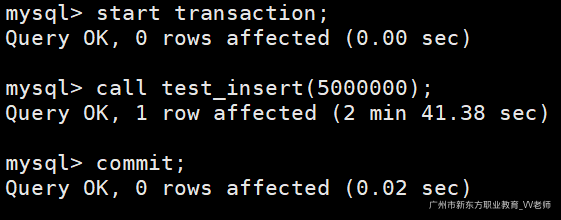
注意:插入海量数据时,尽量在同一个事务中,因为频繁的开启、提交事务会不停的消耗锁资源,效率非常低。
show profiles:用于查询SQL语句执行时,具体步骤消耗的时间,以及资源消耗的情况。
show profiles是MySQL5.0版本推出的款新的SQL语句调优工具,可以通过select @@have_profiling来查看当前数据库是否支持show profiles命令。

可以看出我们当前安装的数据库是支持show profiles命令的。
show profiles命令默认是关闭的,我们可以通过命令查看是否开启:
show variables like 'profiling';

开启show profiles命令:
set profiling=1;
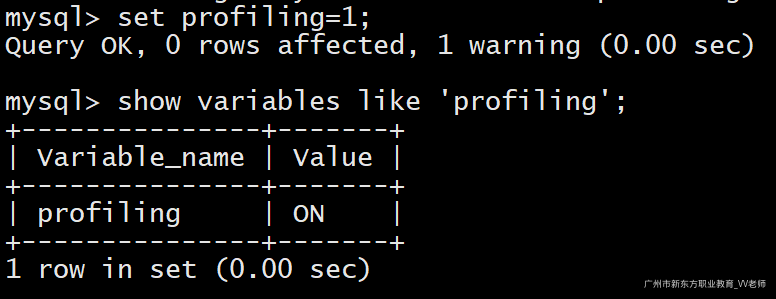
我们随便执行几条SQL语句之后执行show profiles命令:
select count(*) from userinfo;
select * from userinfo where phone='26635084791';
select * from userinfo where id=1000;
show profiles;

Query_ID:系统给此SQL语句派发的查询ID号。
Duration:执行SQL语句所消耗的时间。
Query:执行的SQL语句。
- 根据查询ID号获取具体某条SQL的详细执行情况:
show profile for query query_id;
show profile for query 5;

经排查发现,SQL语句大部分时间都消耗在Sending data阶段了。
Tips:Sending data代表的是执行SQL语句,到服务端完全响应结果的整个过程消耗的时间。而不是单单发送这条SQL语句所消耗的时间。
1.2.3 查询SQL执行频率
在mysql的系统变量中,维护着许多我们执行的记录,包括基本的增、删、改、查,索引、改表操作、执行存储过程等,我们可以查询这些系统变量来翻阅我们执行某些SQL语句的频次。
show status like '%com%';
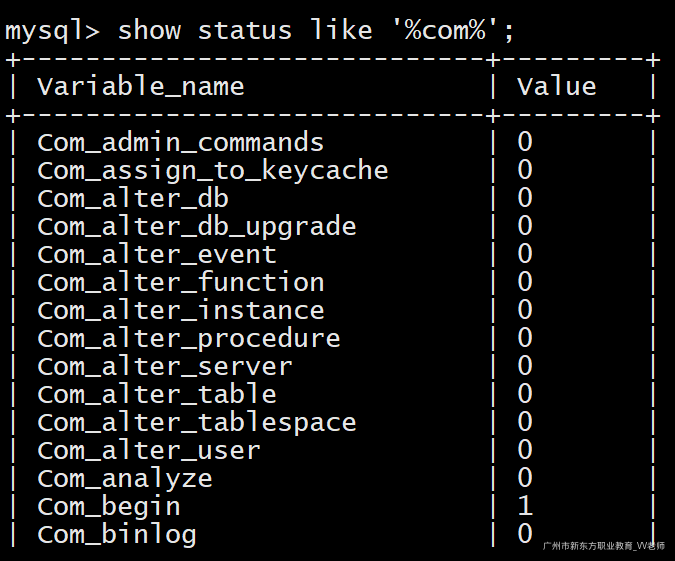
我们可以通过字符个数筛选我们需要的数据:
show status like 'Com_______';
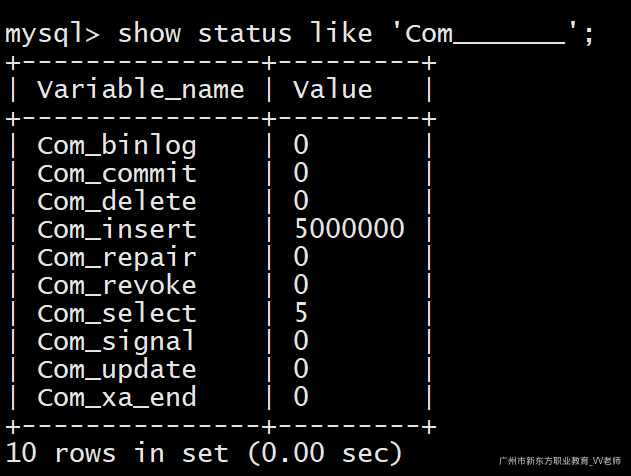
默认查询的是本次连接执行的次数,可以通过加上global来查询全局的执行情况,即数据库服务器开启到现在执行SQL的频次。
show global status like 'Com_______';

只查询InnoDB存储情况的SQL语句执行情况:
show status like 'Innodb_rows_%';

二、索引使用原则
1.1 索引匹配规则
1.1.1 全值匹配
全值匹配是针对建立了复合索引的索引列,在查询条件中,复合索引的所有列都指定具体的列。
为了提升查询效率,我们把表清空:
truncate userinfo;
- 创建复合索引:
create index idx on userinfo(username,age,phone,gender);
- 执行全值匹配SQL:
explain select * from userinfo where username='1' and age=1 and phone='1' and gender='1';

1.1.2 最左前缀法则
最左前缀法则指的是,查询条件中如果包含有复合索引,必须从索引的最左列开始查询。并且不跳过中间列。
- 测试最左前缀法则(1):
explain select * from userinfo where age=20; -- 不走索引
explain select * from userinfo where phone='1'; -- 不走索引
explain select * from userinfo where gender='1'; -- 不走索引
explain select * from userinfo where username='1'; -- 走索引
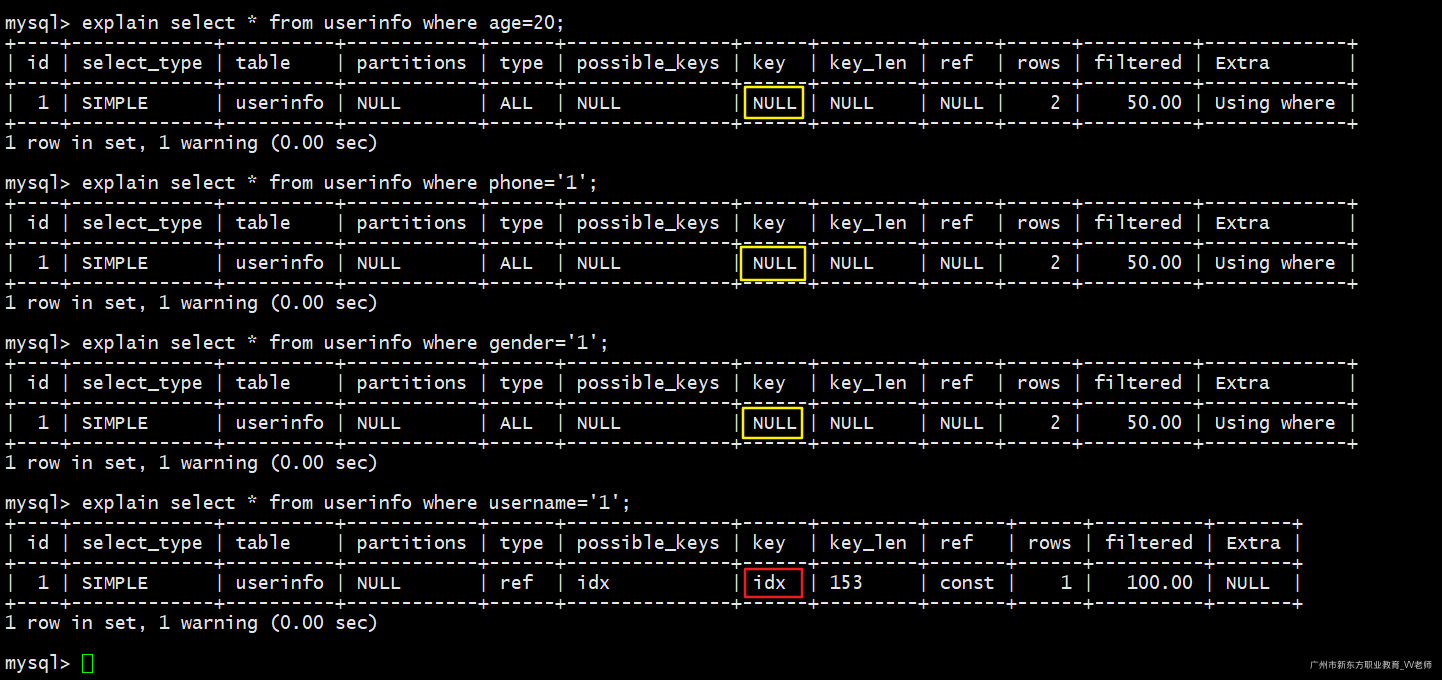
- 测试最左前缀法则(2):
最左匹配原则,必须要匹配最左的索引列,不可跳过最左边索引列
-- 不走索引
explain select * from userinfo where phone='1' and age=20 and gender='1';
-- 不走索引
explain select * from userinfo where gender='1' and age=20 and phone='1';
-- 不走索引
explain select * from userinfo where phone='1' and gender=20 and age='1';
-- 命中1个字段(username)
explain select * from userinfo where username='1' and phone='1' and gender='1';
-- 命中2个字段(username、age)
explain select * from userinfo where username='1' and age=1 and gender='1';
-- 命中3个字段(username、age、phone)
explain select * from userinfo where username='1' and age=20 and phone='1';

注意:最左前缀法则指的是条件匹配时,必须匹配上创建索引时最左边的列,跟where指定的条件顺序无关!
-- 命中1个字段(username)
explain select * from userinfo where gender='1' and phone='1' and username='1';
-- 命中2个字段(username、age)
explain select * from userinfo where age=1 and gender='1' and username='1';
-- 命中3个字段(username、age、phone)
explain select * from userinfo where age=1 and phone='1' and username='1';

- 如果四个值都匹配了,既符合最左前缀法则,也符合全值匹配
-- 全部命中
explain select * from userinfo where username='1' and age=1 and phone='1' and gender='1';

测试完毕删除复合索引:
drop index idx on userinfo;
1.1.3 复合索引底层原理
我们刚刚了解到使用复合索引时,要遵循最左前缀法则,即查询时必须要匹配最左的索引列,不可跳过最左边索引列,但具体是为什么呢?我们必须从复合索引底层的B+Tree说起
假设我们建立一个以gender和age列的复合索引:
create index idx on userinfo(gender,age);
假设我们插入的数据是:
insert into userinfo(gender,age) values
(1,20),(0,18),(0,21),(1,25),(0,26),(1,17),(1,20);
底层B+Tree构建情况:
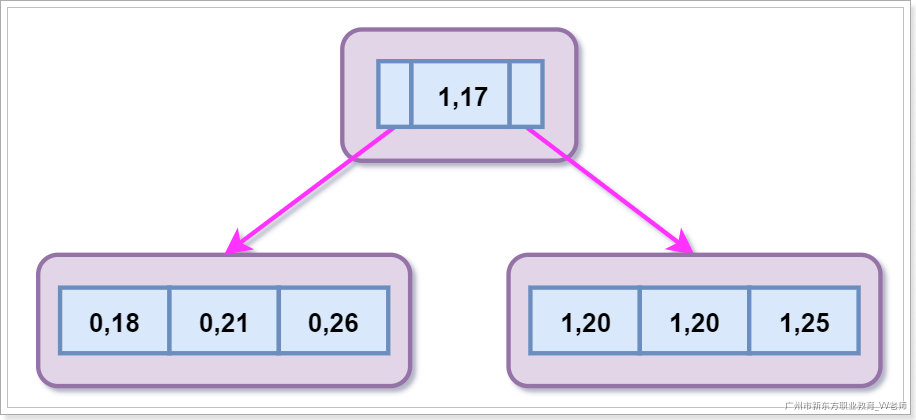
从复合索引的底层B+Tree上可以看出来gender列是有顺序的,age列是没有顺序的,但是细心观察发现在gender列值相同的情况下,age列是有顺序的;这是因为MySQL在构建复合索引的B+Tree时默认根据最左边的第一个字段进行排序,在第一个字段的基础上然后对第二个字段进行排序,以此类推......;因此我们在查询的过程中如果跳过了最左边的列那么这颗B+Tree是不能起作用的;
测试完毕删除索引:
drop index idx on userinfo;
1.1.4 复合索引的好处
1.1.4.1 使用覆盖索引
假设此时有复合索引(username,age,gender),再查询如下的SQL:
- 创建复合索引:
create index idx_name on userinfo(username,age,gender);
执行SQL:
explain select username,age,gender from userinfo where username='' and age=20;

MySQL可以直接通过遍历索引取得数据,而无需回表操作(使用覆盖索引);
删除复合索引:
drop index idx_name on userinfo;
- 分别为username、age、gender列创建索引:
create index idx_name on userinfo(username);
create index idx_age on userinfo(age);
create index idx_gender on userinfo(gender);
执行SQL:
explain select username,age,gender from userinfo where username='';
explain select username,age,gender from userinfo where username='' and age=1;
explain select username,age,gender from userinfo where username='' and age=1 and gender='1';
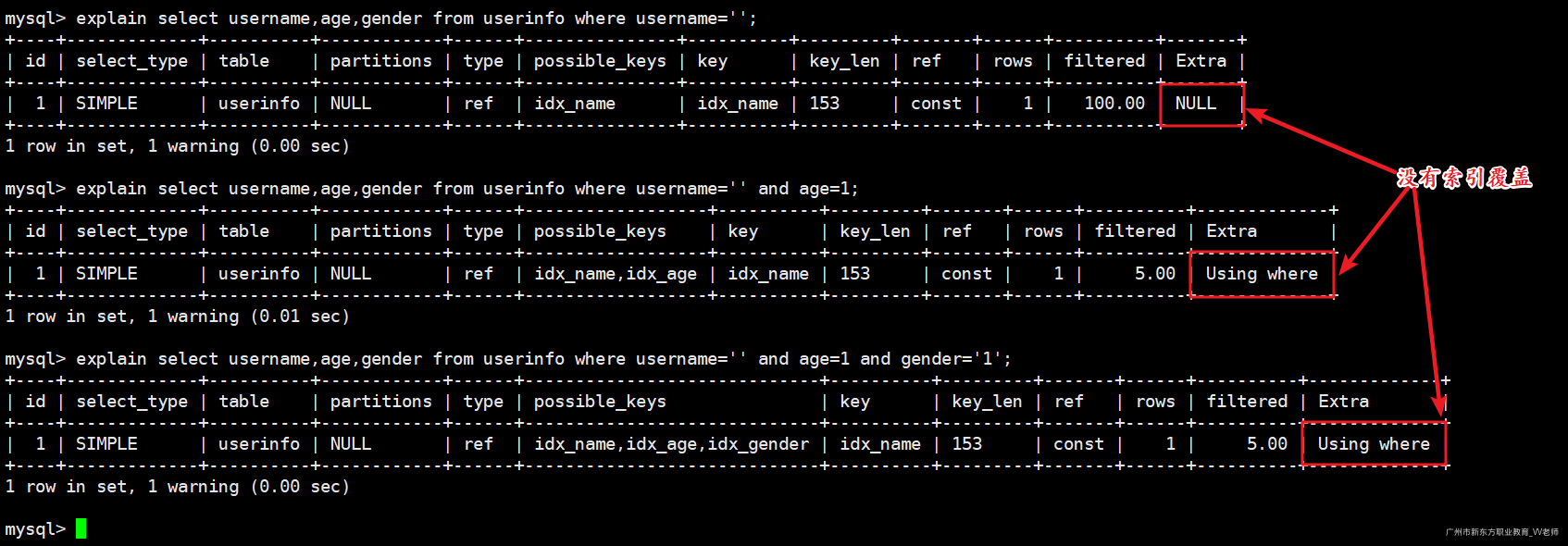
发现使用单列索引多个值匹配时,会造成索引失效;即使用到了idx_name索引做username条件的检索,剩下的数据并没有使用idx_age和idx_gender索引进行数据的检索;
测试完毕删除索引:
drop index idx_name on userinfo;
drop index idx_age on userinfo;
drop index idx_gender on userinfo;
1.1.4.2 减少磁盘开销
我们通过前面分析的复合索引底层原理时不难发现,当我们建立了一列(name,age,gender)复合索引时,其实是建立了(name)、(name、age)、(name、age、gender)三个索引,每增加一个索引都会增加写操作的开销。尤其在大数量的表中,使用复合索引可以大大减少IO的开销,提升效率!
1.1.4.3 查询效率高
索引的列越多,通过索引筛选出来的数据就会越少;假设此时表中有1000W的数据,有如下SQL:select from table where col1=1 and col2=2 and col3=3;,假设每个条件可以筛选出10%的数据;
- 单列索引:通过第一个索引筛选出100W条数据,然后进行二次筛选查询(不使用索引)剩下10W数据,然后再进行第三次查询(不使用索引),剩下1W数据
- 复合索引:三次筛选都是用到索引,速度快;
1.2 索引失效
1.2.1 单列索引失效
创建单列索引:
create index idx_name on userinfo(username);
1)失效情况一:
不要在索引列上做任何的操作,否则索引将失效
explain select * from userinfo where username='1'; -- 走索引
explain select * from userinfo where concat(username,'1')='1'; -- 不走索引

2)失效情况二:
字符串类索引在条件查询时,条件值没有加双引号,索引失效
explain select * from userinfo where username='1'; -- 走索引
explain select * from userinfo where username=1; -- 不走索引

3)失效情况三:
尽量避免**select ***,以及多余的字段。由于索引树上没有直接的数据,需要回表查询(但比Using where 要快的多)
explain select * from userinfo where username='1'; -- 回表
explain select username,age from userinfo where username='1'; -- 回表
explain select username from userinfo where username='1'; -- 不需要回表
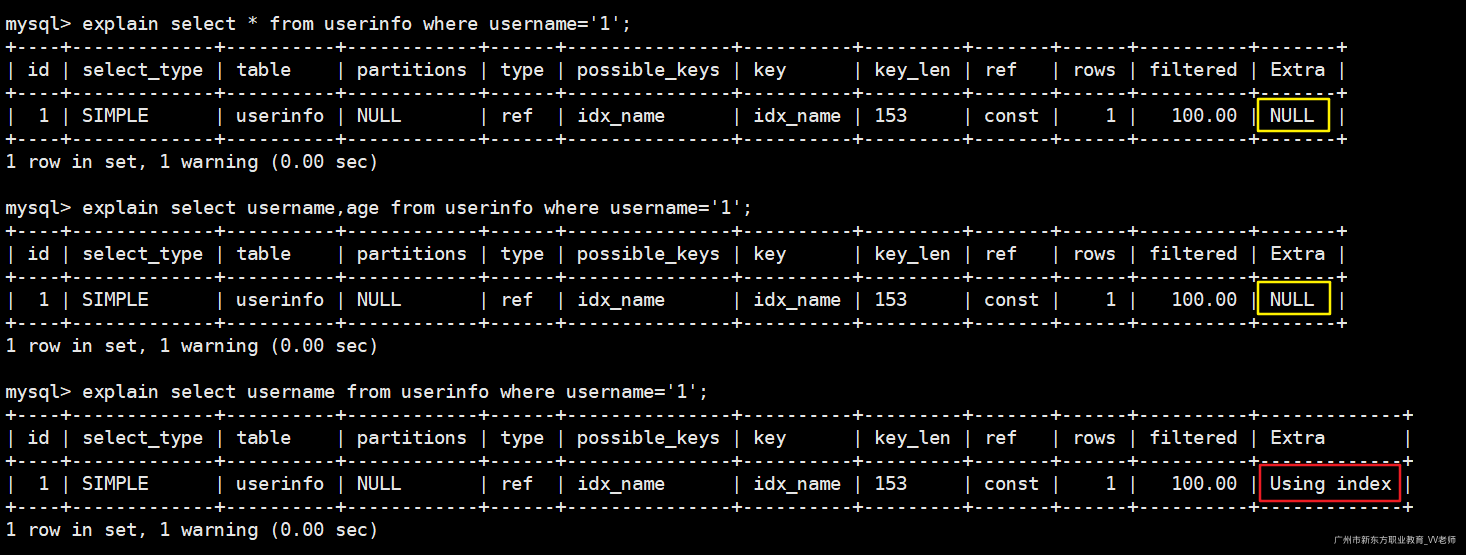
4)失效情况四:
使用不等于(**!=**** 或者**<>**)不会命中索引**
测试SQL:
explain select * from userinfo where username='1'; -- 走索引
explain select * from userinfo where username!='1'; -- 不走索引

5)失效情况五:
like,前通配符会导致索引失效,没有使用通配符或者使用后通配符会使用索引,但是会造成回表
explain select * from userinfo where username like '%1%'; -- 不走索引
explain select * from userinfo where username like '%1'; -- 不走索引
explain select * from userinfo where username like '1%'; -- 走索引,回表
explain select * from userinfo where username like '1'; -- 走索引,回表

tips:Using index condition和NULL都是走了索引,但是会回表查询。
因此一般需要频繁模糊查询并且数据量比较大的情况下,一般会取业务前缀;比如数据前面加某个前缀符。
explain select * from userinfo where username like 'T%1';

我们插入300W条数据,观察一下加前缀和未加前缀的效率:
start transaction; -- 开启事务(控制在一个事务中,避免频繁开启/提交事务)
set unique_checks=0; -- 关闭唯一性校验
call test_insert(3000000); -- 插入300W测试数据
commit; -- 提交事务
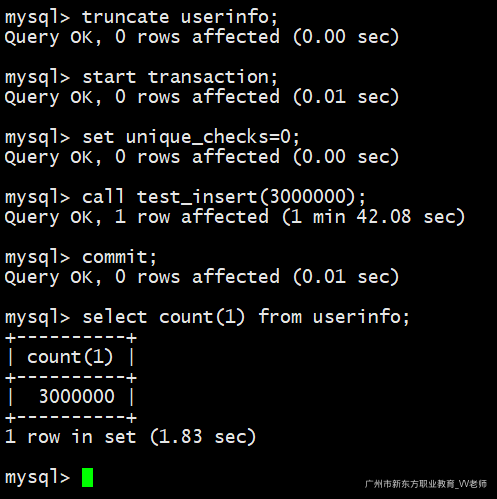
执行查询:
-- 索引生效
select * from userinfo where username like 'T%1';
-- 索引失效
select * from userinfo where username like '%1';
-- 索引生效
select * from userinfo where username like 'T%1%';
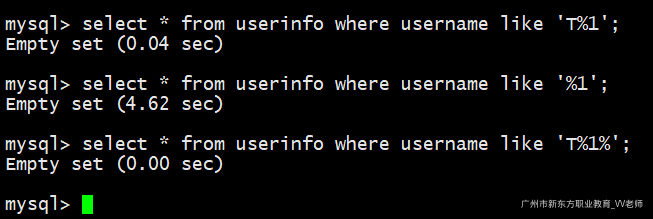
测试完毕清空表:
truncate userinfo;
6)失效情况六:
is null会走索引,is not null不会走索引。
explain select * from userinfo where username is null;
explain select * from userinfo where username is not null;

7)失效情况七
使用not in会导致索引失效
explain select * from userinfo where username in ('1');
explain select * from userinfo where username not in ('1');

测试完毕删除索引:
drop index idx_name on userinfo;
8)失效情况八:
使用or来拼接条件会导致复合索引失效。
我们知道MySQL要想命中复合索引,必须按照最左前缀法则,回顾最左前缀法则:
create index idx_name_age_phone on userinfo(username,age,phone); -- 创建复合索引
show index from userinfo; -- 查询当前索引有哪些

只有一个复合索引(username、age、phone);
执行如下SQL语句,分析执行计划
explain select * from userinfo where username='1'; -- 命中一个索引
explain select * from userinfo where username='1' and age=1; -- 命中两个索引
explain select * from userinfo where username='1' and phone='1';-- 命中一个索引(username)
explain select * from userinfo where age=1 and phone='1'; -- 不符合最左前缀法则

上述条件都是使用and拼接,如果一旦使用了or,索引会立即失效,不管是否符合最左前缀法则。也不管是否复合全值匹配
-- 符合最左前缀法则(不走索引)
explain select * from userinfo where username='1' or age=1;
-- 复合最左前缀法则也复合全值匹配(不走索引)
explain select * from userinfo where username='1' or age=1 or phone='1';

测试完毕删除索引:
drop index idx_name_age_phone on userinfo;
1.2.2 复合索引解决部分单列索引失效问题
当多个列都创建了索引(不是复合索引),同时使用这几个索引列查询时,MySQL只会选择其中一个索引去查询,查询到结果之后,根据另一个索引条件进行条件筛选。
给name、age列创建索引:
create index idx_name on userinfo(username);
create index idx_age on userinfo(age);
测试条件使用到多个单列索引:
explain select * from userinfo where username='1'; -- 走索引
explain select * from userinfo where age=1; -- 走索引
-- 先走idx_name索引查询,然后根据age筛选剩余的数据(这个时候不走索引)
explain select * from userinfo where age=1 and username='1';

其实这条SQL语句的效率也是非常高的,因为使用了idx_name索引先检索出来一部分数据,这个时候是非常快的,然后剩下的数据再通过age条件筛选,但是通过第一轮的筛选剩下来的数据已经非常少了。此时即使不通过索引筛选剩下的数据也是非常快的,除非第一轮筛选过后的的数据量还是非常多(十万、百万),那么第二次不使用索引筛选效率就会比较低了。
针对于上述情况,我们可以根据username和age两列建立复合索引,来解决这个问题。
建立复合索引之前删除前面的两个索引(不删除不行,因为idx_name索引先创建的,如果不删那么会默认选择idx_name索引来查询数据,而不会使用后面创建的复合索引):
drop index idx_name on userinfo;
drop index idx_age on userinfo;
建立复合索引:
create index idx_name_age on userinfo(username,age);
执行SQL:
explain select * from userinfo where age=1 and username='1';

1.3 ICP索引条件下推
1.3.1 什么是ICP
ICP(Index Condition Pushdown):即索引条件下推;是MySQL 5.6版本中的新特性,是一种在存储引擎层使用索引过滤数据的一种优化方式。不支持ICP之前,当进行索引查询时,首先根据索引来查找数据,然后再根据where条件来过滤(没有用到索引),扫描了大量不必要的数据,增加了数据库IO操作。
索引条件下推是对使用索引从表中检索行的一种优化。
- 不使用icp:存储引擎先根据索引查询然后去表(聚集索引)中去定位所需要的行,并将其返回给MySQL服务器,然后服务器进行where条件的过滤。
- 使用icp:如果where的部分列可以使用索引中的列来过滤,则MySQL服务器会将这部分条件下推到存储引擎,存储引擎使用索引条目来计算已推入的索引条件,只有满足这个条件,才从表中读取行。从而减少存储引擎访问表的次数和mysql服务器访问存储引擎的次数
1.3.2 没有启用ICP
使用二级索引查询到记录(假设有4行数据),之后回表读取完整的记录行(4行),然后MySQL服务器在返回的记录行中根据where条件进行过滤(在4行数据中进行过滤),最终得到数据结果集;

Tips:没有启用ICP的情况下,第一次根据二级索引查询出来的数据,第二次查询没有使用到索引,效率低;
1.3.3 启用了ICP:
使用二级索引查询到记录(4条记录),然后再根据二级索引的列在这4条数据里面进行筛选出符合条件的数据(条件下推到存储引擎),最终得到数据结果集;
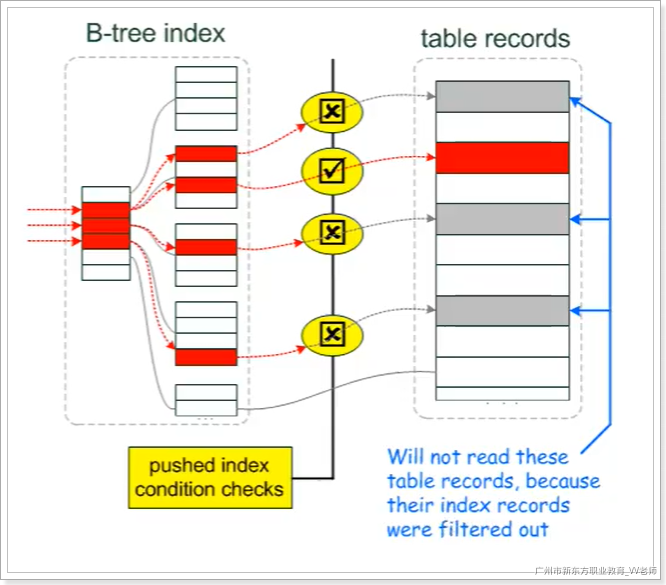
Tips:开启了ICP之后,其他列的条件不能通过索引来检索数据时,MySQL服务器会将条件下推到存储引擎再次进行条件过滤,最终命中一条结果集;
1.3.4 ICP案例
开启ICP:
MySQL是默认开启ICP的,我们可以通过优化器开关参数查看ICP的状态:
-- 查询优化器相关参数
show variables like 'optimizer_switch';
-- 关闭ICP
set optimizer_switch='index_condition_pushdown=off'
-- 开启ICP
set optimizer_switch='index_condition_pushdown=on'
案例SQL:
CREATE TABLE `t_emp` (
`id` int(11) NOT NULL AUTO_INCREMENT,
`last_name` varchar(255) CHARACTER SET latin1 COLLATE latin1_swedish_ci NULL DEFAULT NULL COMMENT '姓',
`first_name` varchar(255) CHARACTER SET latin1 COLLATE latin1_swedish_ci NULL DEFAULT NULL COMMENT '名',
PRIMARY KEY (`id`) USING BTREE,
INDEX `idx_last`(`last_name`) USING BTREE,
INDEX `idx_first`(`first_name`) USING BTREE -- 两个索引
) ENGINE = InnoDB AUTO_INCREMENT = 9 CHARACTER SET = latin1 COLLATE = latin1_swedish_ci ROW_FORMAT = Dynamic;
INSERT INTO `t_emp` VALUES (1, 'li', 'ming');
INSERT INTO `t_emp` VALUES (2, 'wang', 'gang');
INSERT INTO `t_emp` VALUES (3, 'zhang', 'xin');
INSERT INTO `t_emp` VALUES (4, 'wang', 'xiaoxiao');
INSERT INTO `t_emp` VALUES (5, 'chen', 'fei');
INSERT INTO `t_emp` VALUES (6, 'wang', 'xie');
INSERT INTO `t_emp` VALUES (7, 'zhang', 'long');
INSERT INTO `t_emp` VALUES (8, 'wang', 'jun');
开启ICP的执行计划:
desc select * from t_emp where last_name='wang' and first_name like 'gang%';

关闭ICP的执行计划:
set optimizer_switch='index_condition_pushdown=off';
desc select * from t_emp where last_name='wang' and first_name like 'gang%';

三、SQL语句优化
3.1 海量数据插入优化
3.1.1 load 加载数据
当我们有海量数据需要插入时(几百万、几千万),我们可以借助load命令,帮我们加载数据
准备表:
CREATE TABLE `userinfo_1` (
`id` int(10) NOT NULL COMMENT '用户id',
`username` varchar(50) CHARACTER SET utf8 COLLATE utf8_general_ci NULL DEFAULT NULL COMMENT '用户名',
`age` int(3) NULL DEFAULT NULL COMMENT '年龄',
`phone` varchar(15) CHARACTER SET utf8 COLLATE utf8_general_ci NULL DEFAULT NULL COMMENT '手机号',
`gender` char(1) CHARACTER SET utf8 COLLATE utf8_general_ci NULL DEFAULT NULL COMMENT '性别: ‘0’-男 ‘1’-女',
`desc` text CHARACTER SET utf8 COLLATE utf8_general_ci NULL COMMENT '自我介绍',
`register_time` datetime(0) NULL DEFAULT NULL COMMENT '注册时间',
`login_time` datetime(0) NULL DEFAULT NULL COMMENT '上一次登录时间',
`pic` varchar(250) CHARACTER SET utf8 COLLATE utf8_general_ci NULL DEFAULT NULL COMMENT '头像地址',
`look` int(10) NULL DEFAULT NULL COMMENT '查看数',
PRIMARY KEY (`id`)
) ENGINE = InnoDB CHARACTER SET = utf8 COLLATE = utf8_general_ci ROW_FORMAT = Compact;
查看原始数据:
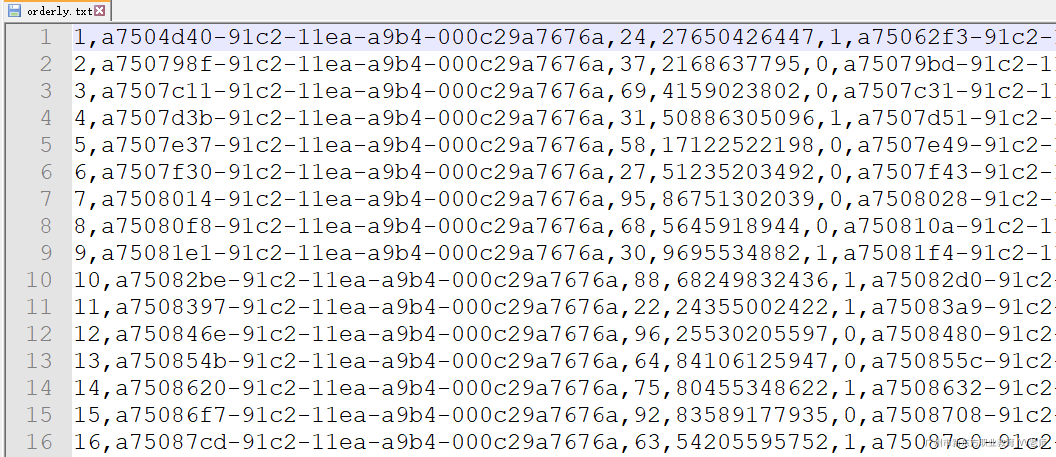
使用load命令加载数据:
load data local infile '/root/orderly.txt' into table userinfo_1 fields terminated by ',' lines terminated by '\n';
/root/orderly.sql:要加载的数据脚本
,:数据的分隔符
\n:数据的换行符

从上面可以看出,插入100W的数据只需要7.2秒左右的时间。
3.1.2 顺序优化
InnoDB存储引擎的按照主键的顺序来排列行的,如果主键的顺序大量不一致,插入数据时需要频繁更新索引结构,影响插入效率。因此我们可以将数据按照主键的顺序进行排列,来提高插入速度。需要注意的是,如果表中没有主键,InnoDB会自动创建一个默认的内部列作为主键
刚刚在上面看到了顺序插入时,100W数据的插入时间为7.2秒左右,我们重新创建一张表,测试插入100W无序的数据所消耗的时间。
先查看两个数据文件的大小是否一致:

完全一致;
- 创建表:
CREATE TABLE `userinfo_2` (
`id` int(10) NOT NULL COMMENT '用户id',
`username` varchar(50) CHARACTER SET utf8 COLLATE utf8_general_ci NULL DEFAULT NULL COMMENT '用户名',
`age` int(3) NULL DEFAULT NULL COMMENT '年龄',
`phone` varchar(15) CHARACTER SET utf8 COLLATE utf8_general_ci NULL DEFAULT NULL COMMENT '手机号',
`gender` char(1) CHARACTER SET utf8 COLLATE utf8_general_ci NULL DEFAULT NULL COMMENT '性别: ‘0’-男 ‘1’-女',
`desc` text CHARACTER SET utf8 COLLATE utf8_general_ci NULL COMMENT '自我介绍',
`register_time` datetime(0) NULL DEFAULT NULL COMMENT '注册时间',
`login_time` datetime(0) NULL DEFAULT NULL COMMENT '上一次登录时间',
`pic` varchar(250) CHARACTER SET utf8 COLLATE utf8_general_ci NULL DEFAULT NULL COMMENT '头像地址',
`look` int(10) NULL DEFAULT NULL COMMENT '查看数',
PRIMARY KEY (`id`)
) ENGINE = InnoDB CHARACTER SET = utf8 COLLATE = utf8_general_ci ROW_FORMAT = Compact;
原始数据:

主键无序
- 执行load命令:
load data local infile '/root/disorder.txt' into table userinfo_2 fields terminated by ',' lines terminated by '\n';

同样的数据量,顺序排列的数据插入时间为7.6秒,无序排列插入的数据为46.73秒。
3.1.3 锁优化
在海量数据插入时,保证插入的数据在同一个事务,或者改为手动提交事务。否则MySQL将每一个插入操作都包含这三个操作:开启事务、执行插入、提交事务。频繁的开启锁、释放锁,给性能上带来的极大的消耗。
清空userinfo表:
truncate userinfo;
使用我们前面创建的存储过程插入100W条记录(保证在同一个事务):
start transaction;
call test_insert(1000000);
commit;
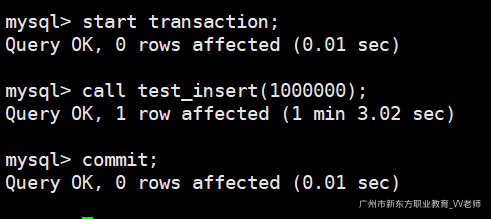
花费1分03秒。
直接执行存储过程,不在同一个事务(频繁开启、释放锁、记录事务日志等):效率极低
call test_insert(1000000);
花费时间超高,有兴趣的可以测试一下;
3.1.4 唯一性校验
在MySQL插入时,会有数据的唯一性校验操作,我们在导入海量数据时,关闭唯一性校验,提高插入速度。
我们先将表清空:
truncate userinfo;
关闭唯一性校验:
show variables like "UNIQUE_CHECKS";
SET UNIQUE_CHECKS=0;
调用存储过程插入100W数据:
start transaction;
call test_insert(1000000);
commit;

花费24.32秒。
3.1.5 insert优化
我们在插入的时候,尽量把多个insert语句优化成一个insert语句进行插入,这样可以有效提高插入的速度
insert into xx values(col1,col2);
insert into xx values(col1,col2);
insert into xx values(col1,col2);
优化成:
insert into xx values(col1,col2),(col1,col2),(col1,col2);
我们做个测试:
准备两个SQL文件(各100W数据),一个是优化前的,一个是优化后的,执行优化后的sql语句导入:
mysql -uroot -padmin < /root/test.sql

执行test.sql脚本(优化后的),导入100W数据,大约花了14s。
执行优化前的SQL:
mysql -uroot -padmin < /root/test2.sql
有兴趣的可以测试一下,速度超慢
3.2 语句优化
3.2.1 排序优化
1)索引优化:
在排序时,尽量使用索引字段进行排序,否则会采用文件排序(filesort),效率低。
根据普通字段排序:
show index from userinfo; -- 查询当前表有多少索引
explain select * from userinfo order by username; -- 根据普通字段排序

给排序字段创建索引:
create index idx_name on userinfo(username); -- 创建索引
explain select * from userinfo order by username; -- filesort
explain select username from userinfo order by username; -- Using index
explain select username,age from userinfo order by username; -- filesort
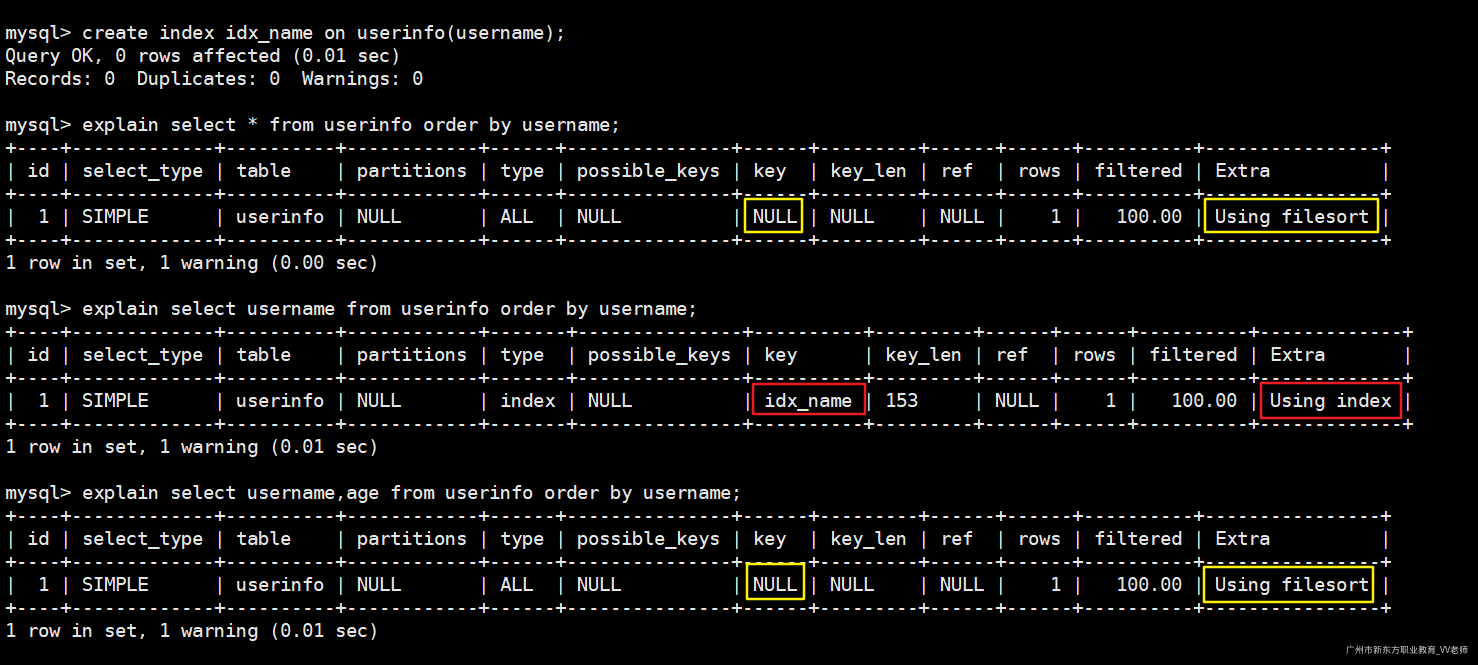
根据索引字段排序,之后查询的数据必须是索引数上的数据,不可查询额外字段,更不能查询全表字段
2)算法优化:
MySQL在排序时,如果不能够借助索引直接完成排序,那么将会使用文件排序(filesort)。如果使用了filesort,那么MySQL会将数据在内存中进行排序,排序内存由系统变量sort_buffer_size控制。默认为256KB。
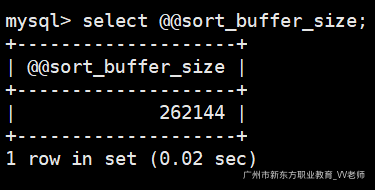
注意,排序缓冲区是每个线程是独享的。
MySQL的排序算法分为两种:
- 多扫描排序:首先根据排序条件取出排序字段的行指针信息,然后在排序缓冲区(
sort_buffer_size)中进行排序。排序完毕之后会根据排序缓冲区中的行指针回表查询。操作磁盘次数多(两次),效率较低。 - 单扫描排序:根据条件取出所有字段的信息(不仅仅是排序字段),然后在排序缓冲区中进行排序,排序完毕之后直接将结果集返回。这一步对排序缓冲区要求比较大,但排序效率高。
1、如果排序缓冲区大小不足,那么则会采用临时表(
temporary table)存储排序结果。之后临时表的行指针信息重新回表查询记录。效率低2、每个线程都有自己独自的排序缓冲区,如果排序缓冲区设置过大,会浪费内存。
那MySQL到底采用哪种排序算法?
MySQL4.1版本之前只有多扫描排序算法,单扫描排序是MySQL4.1版本推出的新排序算法,用于优化多扫描排序。MySQL主要根据系统变量max_length_for_sort_data的大小和此次Query语句所取出的所有字段类型大小之后对比,如果max_length_for_sort_data大,则使用单扫描排序,反之使用多扫描排序。
查询max_length_for_sort_data的默认值:
select @@max_length_for_sort_data;

max_length_for_sort_data默认1KB。
3.2.2 分组优化
在MySQL中group by语句会触发一次默认的order by排序操作,造成不必要的性能浪费。我们可以手动的禁止分组操作带来的排序操作。
测试:
CREATE TABLE `student` ( -- 学生表
`id` int(11) NOT NULL,
`name` varchar(255) CHARACTER SET utf8 COLLATE utf8_general_ci NULL DEFAULT NULL,
`age` int(11) NULL DEFAULT NULL,
`c_id` int(11) NULL DEFAULT NULL, -- 班级id
PRIMARY KEY (`id`) USING BTREE
) ENGINE = InnoDB CHARACTER SET = utf8 COLLATE = utf8_general_ci ROW_FORMAT = Dynamic;
CREATE TABLE `class` ( -- 班级表
`id` int(11) NOT NULL,
`name` varchar(255) CHARACTER SET utf8 COLLATE utf8_general_ci NULL DEFAULT NULL,
PRIMARY KEY (`id`) USING BTREE
) ENGINE = InnoDB CHARACTER SET = utf8 COLLATE = utf8_general_ci ROW_FORMAT = Dynamic;
INSERT INTO `test`.`class`(`id`, `name`) VALUES (1, 'Java01');
INSERT INTO `test`.`class`(`id`, `name`) VALUES (2, 'Java02');
INSERT INTO `test`.`class`(`id`, `name`) VALUES (3, 'Java03');
INSERT INTO `test`.`student`(`id`, `name`, `age`, `c_id`) VALUES (1, '小红', 28, 3);
INSERT INTO `test`.`student`(`id`, `name`, `age`, `c_id`) VALUES (2, '小军', 25, 1);
INSERT INTO `test`.`student`(`id`, `name`, `age`, `c_id`) VALUES (3, '小明', 24, 2);
INSERT INTO `test`.`student`(`id`, `name`, `age`, `c_id`) VALUES (4, '小龙', 19, 1);
INSERT INTO `test`.`student`(`id`, `name`, `age`, `c_id`) VALUES (5, '小蓝', 29, 3);
INSERT INTO `test`.`student`(`id`, `name`, `age`, `c_id`) VALUES (6, '小刚', 25, 2);
根据班级id(c_id)计算每个班级平均年龄:
mysql> select avg(age),c_id from student group by c_id;
+----------+------+
| avg(age) | c_id |
+----------+------+
| 22.0000 | 1 |
| 24.5000 | 2 |
| 28.5000 | 3 |
+----------+------+
3 rows in set (0.00 sec)
mysql>
发现默认根据c_id排序了。
如果我们自己手动去除排序结果应该是这样的:
mysql> select avg(age),c_id from student group by c_id order by null;
+----------+------+
| avg(age) | c_id |
+----------+------+
| 28.5000 | 3 |
| 22.0000 | 1 |
| 24.5000 | 2 |
+----------+------+
3 rows in set (0.00 sec)
mysql>
查询如下两个SQL的执行计划:
explain select avg(age),c_id from student group by c_id;
explain select avg(age),c_id from student group by c_id order by null;

发现每次的group by 分组操作都会触发一次默认的排序操作,如果我们没有这样的需求,无疑是增加了SQL语句的响应时间
3.2.3 分页优化
通常使用分页查询是来提高我们的查询效率的,因为通常用户不希望一下子查询到那么多的数据,一般是查询前几条数据,此时的分页效率会比较高。但是在分页查询中也会经常遇到一个非常麻烦的问题,那就是limit N,10,即前面跳过N多条记录,只查询N多条记录的后面几条记录。如果N的值非常大,那么效率必然就会很低。
此时数据库有300W记录:
select count(*) from userinfo;
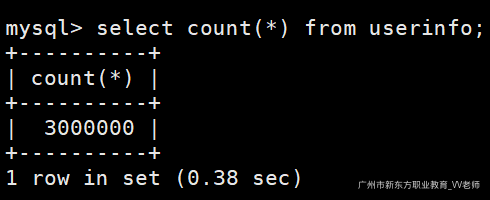
假设我们需要查询2900000-2900010记录:
explain select * from userinfo limit 2900000,10; -- 获取sql的执行计划
select * from userinfo limit 2900000,10; -- 执行sql,查看消耗的时间

从执行计划可以看出,进行了全表扫描,花费的时间为:

显然,效率非常低。
1)优化一
我们可以借助索引,在索引上面排序,然后通过索引关联表查询。
explain select * from userinfo u1,(select id from userinfo order by id limit 2900000,10) t where u1.id=t.id;

查看执行消耗时间:

2)优化二
如果id是顺序排列的话,我们可以先根据id进行排序,然后取后面10条。
explain select * from userinfo where id>2900000 limit 10;

查看执行消耗时间:

3.2.4 表优化
3.2.4.1 数据空洞
当我们对数据库表里面的数据进行删除(delete)时,这些行只是被标记为“已删除”,而不是真的从磁盘中物理删除了,因而空间也没有真的被释放回收。而这些被标记的行就是数据空洞。
我们进入/var/lib/mysql/${db_name}目录下查看当前数据库的一些磁盘存储信息;
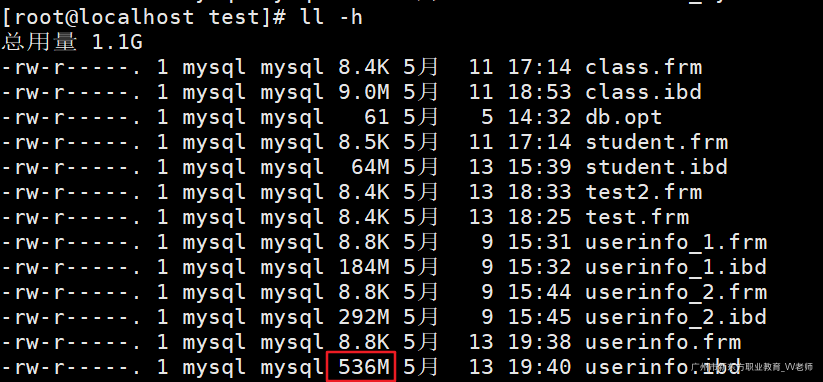
300W记录大概花了536M的空间。
我们删除200W数据再次查看磁盘占用:
start transaction; -- 控制在一个事务中(效率高)
delete from userinfo where id > 1000000;
commit;
再次查看磁盘占用空间,发现还是536M。并没有释放空间。
查看表的数据空洞信息:
mysql> show table status like 'userinfo'\G;
*************************** 1. row ***************************
Name: userinfo
Engine: InnoDB
Version: 10
Row_format: Compact
Rows: 2893050
Avg_row_length: 184
Data_length: 533725184
Max_data_length: 0
Index_length: 50937856
Data_free: 4194304
Auto_increment: NULL
Create_time: 2020-05-13 18:39:36
Update_time: 2020-05-13 18:38:39
Check_time: NULL
Collation: utf8_general_ci
Checksum: NULL
Create_options: row_format=COMPACT
Comment:
1 row in set (0.00 sec)
- Index_length:索引的长度
- Data_free:碎片的数量
3.2.4.2 optimize优化表
当表中存在有大量的数据空洞时,我们可以使用optimize命令来优化表。即删除数据空洞。
1)InnoDB表优化
InnoDB表优化后会做一个重新构建索引+分析的一个过程。因为我们知道InnoDB引擎将数据与索引是放在一个文件中的,名为.idb,对数据进行整理后,必定会对索引造成影响。而MyISAM是将数据与索引文件分开存储的(.MYD、.MYI),因此MyISAM整理空洞不会对索引造成影响。
执行表优化操作:
optimize table userinfo;

InnoDB表优化后,还会对表中的索引进行重构分析。花费时间比myisam表要多一点。
再次查看表,发现占用磁盘空间变小。
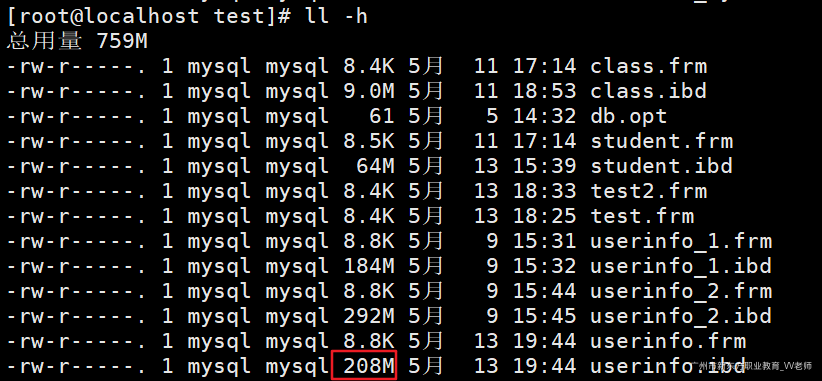
2)MyISAM表优化
创建一张MyISAM表:
CREATE TABLE `userinfo_myisam` (
`id` int(10) NOT NULL COMMENT '用户id',
`username` varchar(50) CHARACTER SET utf8 COLLATE utf8_general_ci NULL DEFAULT NULL COMMENT '用户名',
`age` int(3) NULL DEFAULT NULL COMMENT '年龄',
`phone` varchar(15) CHARACTER SET utf8 COLLATE utf8_general_ci NULL DEFAULT NULL COMMENT '手机号',
`gender` char(1) CHARACTER SET utf8 COLLATE utf8_general_ci NULL DEFAULT NULL COMMENT '性别: ‘0’-男 ‘1’-女',
`desc` text CHARACTER SET utf8 COLLATE utf8_general_ci NULL COMMENT '自我介绍',
`register_time` datetime(0) NULL DEFAULT NULL COMMENT '注册时间',
`login_time` datetime(0) NULL DEFAULT NULL COMMENT '上一次登录时间',
`pic` varchar(250) CHARACTER SET utf8 COLLATE utf8_general_ci NULL DEFAULT NULL COMMENT '头像地址',
`look` int(10) NULL DEFAULT NULL COMMENT '查看数',
PRIMARY KEY (`id`)
) ENGINE = MyISAM CHARACTER SET = utf8 COLLATE = utf8_general_ci ROW_FORMAT = Compact;
编写存储过程,批量插入300W数据:
CREATE PROCEDURE `test_myisam`(count int)
begin
declare i int default 1;
while i<=count do
INSERT INTO userinfo_myisam values(
i,
uuid(),
CEILING(RAND()*90+10),
FLOOR(RAND()*100000000000),
round(FORMAT(rand(),1)),
uuid(),
now(),
now(),
uuid(),
CEILING(RAND()*90+10)
);
set i=i+1;
end while;
end
call test_myisam(3000000); -- 插入300W数据
删除200W数据:
delete from userinfo_myisam where id>1000000;
执行表优化:
optimize table userinfo_myisam;

花费2.65s,比InnoDB效率高,因为InnoDB需要重新构建索引。
再次查看表磁盘占用情况,发现占用空间减少。
Tips:optimize优化命令会进行锁表操作;
3.2.5.3 临时表
MySQL临时表在很多场景中都会用到,比如用户自己创建的临时表用于保存临时数据,以及MySQL内部在执行复杂SQL时,需要借助临时表进行分组、排序、去重等操作。临时表的作用仅限于本次会话,等连接关闭后重新打开连接临时表将不存在。
临时表类型:
- 外部临时表:通过
create temporary table语句创建的临时表,在创建时可以手动指定临时表的存储引擎
create temporary table temp_table(
id int,
name varchar(10)
) ENGINE = InnoDB;
insert into temp_table values (1,'1');
select * from temp_table ;
- 内部临时表:通常在执行复杂SQL语句时,比如group by,distinct,union等语句,执行计划中如果包含Using temporary,那么MySQL内部将使用自动生成的临时表,以辅助SQL的执行。
explain select username from userinfo group by username;
explain select distinct age from userinfo ;
explain select * from userinfo union select * from userinfo;
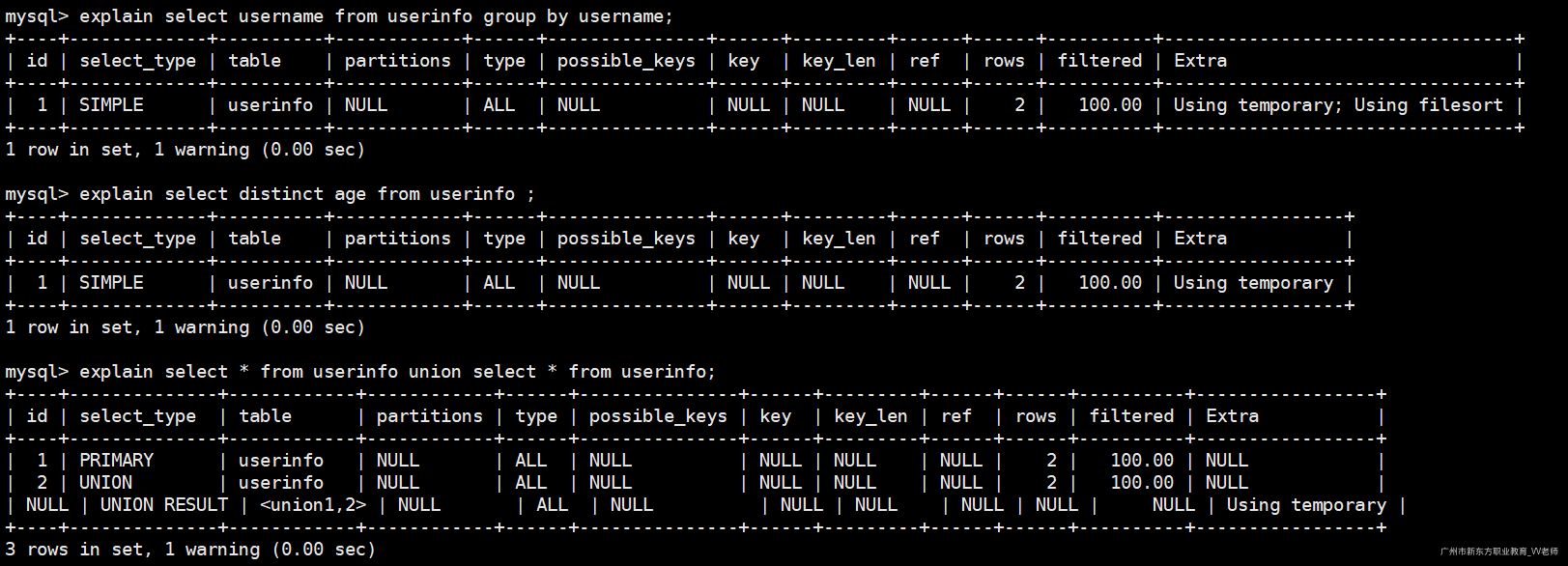
临时表相关系统参数变量
show variables like '%tmp%';

- tmpdir:临时表存储路径
- tmp_table_size:内部临时表内存最大值,超过此值将转移到磁盘中存储。
- max_temp_tables:外部临时表内存最大值,超过此值将转移到磁盘中存储。
- default_tmp_storage_engine:外部临时表默认采用的存储引擎。
- internal_tmp_disk_storage_engine:内部临时表默认采用的存储引擎
临时表相关状态参数
show status like '%tmp%';
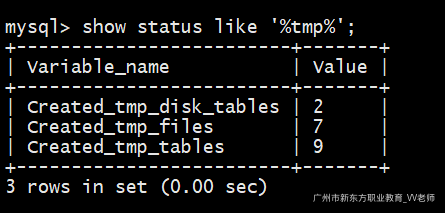
- Created_tmp_disk_tables:MySQL创建内部磁盘临时表次数。
- Created_tmp_tables:MySQL创建内部临时表次数。
- Created_tmp_files:创建的临时表文件数(系统内部维护,不用我们管)。
3.3 SQL Hint
SQL Hint也叫SQL提示, 是帮助我们优化SQL的一个重要的工具。Hint 作为一种 SQL 补充语法,在关系型数据库中扮演着非常重要的角色。它允许用户通过相关的语法影响 SQL 的执行方式,对 SQL 进行特殊的优化。
1)use index & force index
当SQL语句使用索引列查询时,可能针对这个列创建了多个索引,我们可以让MySQL强制使用某个索引,不考虑其他索引。
创建两个索引:
show index from userinfo; -- 查看索引
create index idx_name on userinfo(username); -- 给username创建单列索引
create index idx_name_age on userinfo(username,age); -- 给username、age创建复合索引

执行如下SQL,观察执行计划:
-- 使用先创建的那个索引(idx_name)
explain select * from userinfo where username='1';
-- 强制使用索引idx_name
explain select * from userinfo use index(idx_name) where username='1';
-- 强制使用索引idx_name_age
explain select * from userinfo use index(idx_name_age) where username='1';
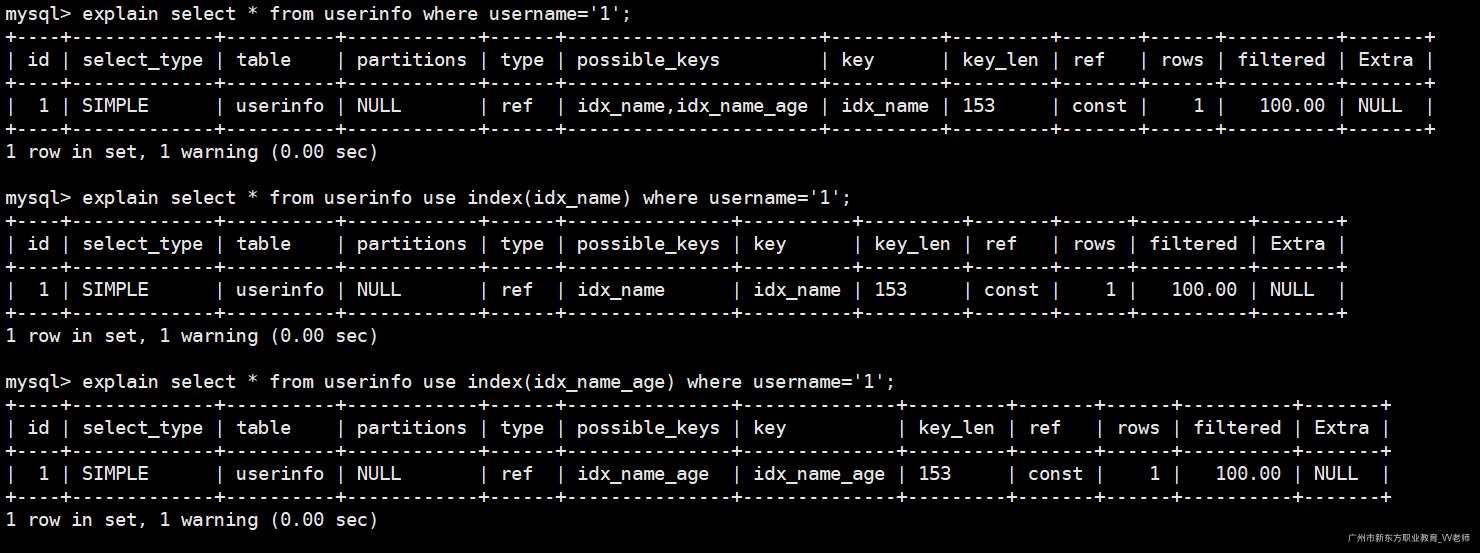
使用use、force都可以让MySQL强制使用某个索引,效果是一样的:
-- 强制使用idx_name索引
explain select * from userinfo force index(idx_name) where username='1';
-- 强制使用idx_name_age索引
explain select * from userinfo force index(idx_name_age) where username='1';

2)ignore index
和use index作用相反,让MySQL忽略某个索引:
-- 忽略idx_name_age索引
explain select * from userinfo ignore index(idx_name_age) where username='1';
-- 忽略idx_name索引
explain select * from userinfo ignore index(idx_name) where username='1';

3)sql_cache
让此sql结果集存入查询缓存中(前提是开启了查询缓存),默认是关闭的,需要我们开启。
查询当前MySQL服务器是否开启查询缓存:(我已经提前开启)
select @@query_cache_type;

查询缓存使用情况:
show global status like '%qcache%';
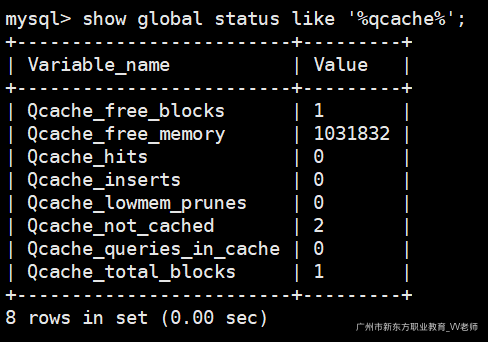
执行SQL:
select SQL_CACHE * from student; -- 将SQL的查询结果放入查询缓存
select SQL_CACHE * from class; -- 将SQL的查询结果放入缓存
4)sql_no_cache
和sql_cache相反,查询结果不放入缓存;
select SQL_NO_CACHE * from student;
5)high_priority
用于提升语句的优先级。我们都知道在MyISAM引擎中,写的操作权限远远比读的要大多了,即使读请求先到达执行队列,写请求后到达,那么MySQL也是默认有限执行写请求,如果在大量的写请求来到MySQL服务器时,会造成读请求不可用(排它锁),因此我们可以设置语句的优先级;
查看当前MySQL是否有降低写的优先级:
select @@LOW_PRIORITY_UPDATES;
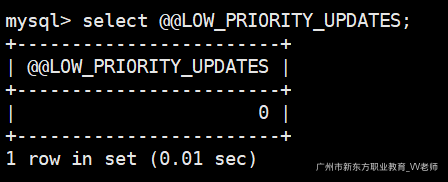
0(OFF):表示没有降低写的优先级(写优先级更高);
1(NO):代表降低了写的优先级(读的优先级更高);
可以通过SQL语句改变MySQL写的优先级:
set LOW_PRIORITY_UPDATES=1;
但是修改之后是本次会话全部的写优先级都修改了(如果想修改全局的加上global)。
我们可以通过high_priority命令来提升本次SQL语句的优先级
select high_priority * from userinfo; -- 提升本次查询操作的优先级
insert high_priority into userinfo(id,username) values(1,'1'); -- 提升本次插入操作的优先级
update high_priority userinfo set username='2' where id=1; -- 语法错误
delete high_priority from userinfo where id=1; -- 语法错误
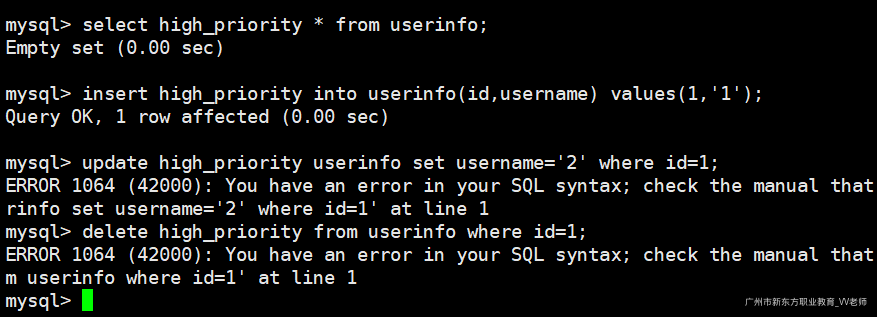
注意:只有查询(select)和插入(insert)语句才可以提高优先级,修改(delete、update)语句不行。
6)low_priority
降低SQL语句的优先级,只有修改(delete、update、insert)语句才可以降低优先级,查询语句是不能降低优先级的。
update low_priority userinfo set username='1' where id=1; -- 降低本次修改操作的优先级
delete low_priority from userinfo where id=1; -- 降低本次删除操作的优先级
insert low_priority into userinfo(id,username) values(2,'1'); -- 降低本次插入操作的优先级
select low_priority from userinfo where id=1; -- 语法错误
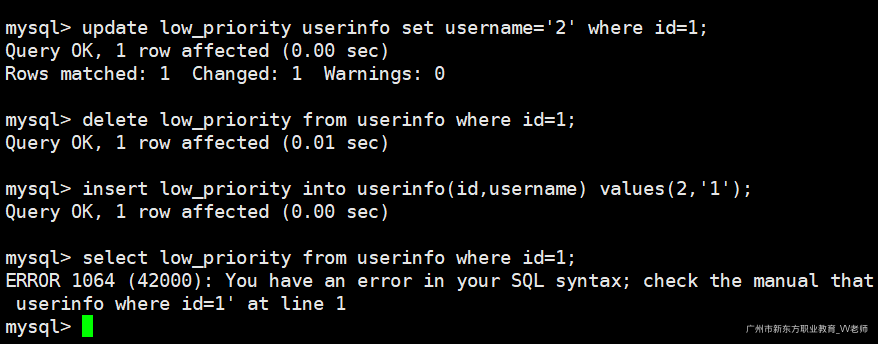
7)insert_delayed
SQL的延时插入;当执行完插入语句时,MySQL并不是立即插入,而是将数据存储在内存队列中,等到MySQL进程有空余时间时再插入,其次这些SQL被集中在一起,执行这些集中的SQL,比执行多个独立的SQL效率要高很多,在实时性要求不高的场景下会给MySQL带来一定的性能提升。
insert delayed into userinfo(id,username) values(3,'3');

8)straight_join
强制指定表的连接顺序,我们知道,所有的SQL语句都会经过MySQL的优化器,进行优化,比如,如下的SQL语句:
explain select * from class c join student s on s.c_id=c.id;
explain select * from student s join class c on c.id=s.c_id;

在上述的内连接中,MySQL的优化器根据"小表驱动大表"的原则,始终选择c表作为驱动表。
我们可以使用straight_join来强制指定驱动表。
explain select * from student s straight_join class c on s.c_id=c.id;
explain select * from class c straight_join student s on s.c_id=c.id;

强制指定左边的表为驱动表
注意:left join 和 right join已经指定了左/右表为驱动表了,因此不能使用straight_join来指定,straight_join一般是应用于内连接查询需要我们来指定驱动表的应用场景。
9)sql_buffer_result
强制将SQL语句的结果集放入内部临时表。
查询当前临时表数量:
mysql> show status like 'Created_tmp_tables';
+--------------------+-------+
| Variable_name | Value |
+--------------------+-------+
| Created_tmp_tables | 6 |
+--------------------+-------+
1 row in set (0.00 sec)
执行SQL语句:
explain select sql_buffer_result * from userinfo;

再次查询临时表数量:
mysql> show status like 'Created_tmp_tables';
+--------------------+-------+
| Variable_name | Value |
+--------------------+-------+
| Created_tmp_tables | 7 |
+--------------------+-------+
1 row in set (0.00 sec)
10)sql_big_result & sql_small_result
- sql_small_result:告诉优化器结果集会很小,可以将结果集放在内存中的临时表;
- sql_big_result:告诉优化器结果集会很大,建议使用磁盘临时表做排序操作;
以上两步操作是我们提示优化器,并不是让优化器强制执行;
explain select sql_small_result username from userinfo group by username;
explain select sql_big_result username from userinfo group by username;
explain select username from userinfo group by username;
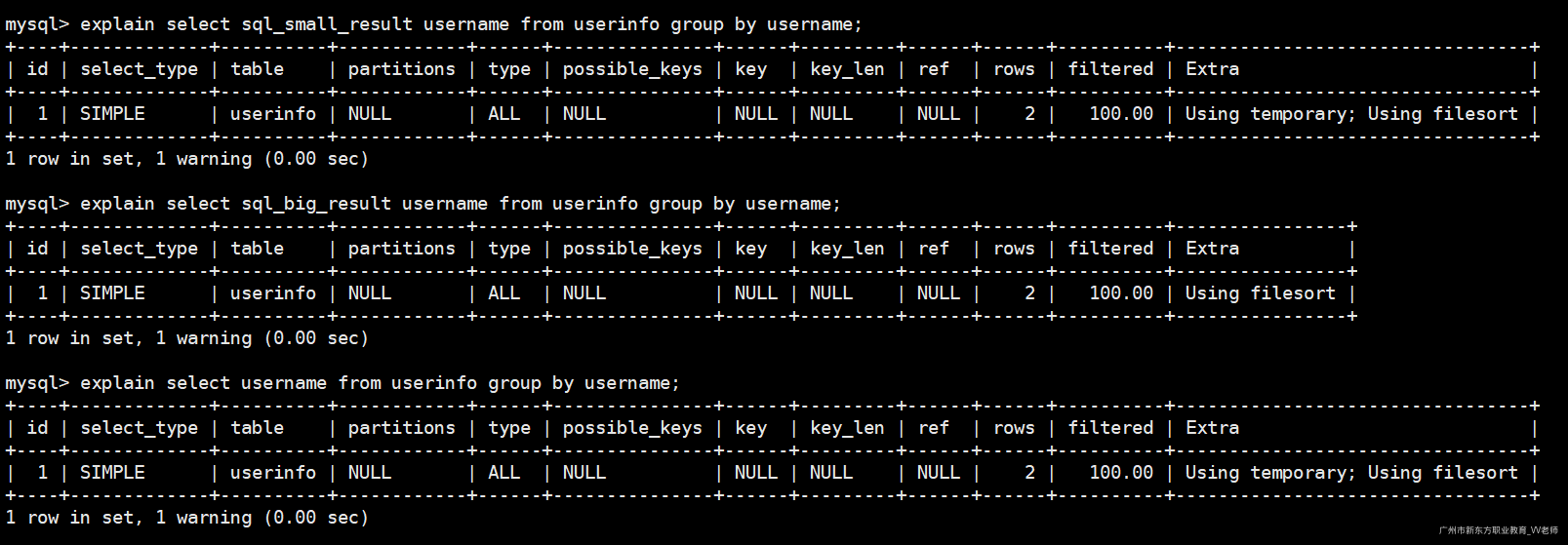


 浙公网安备 33010602011771号
浙公网安备 33010602011771号